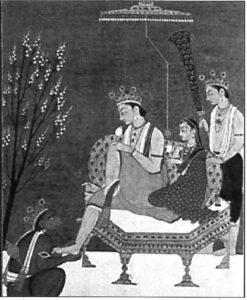The Ramayana, while a tradition that is several thousand years old, is also arguably the most important story in India today, for it is the birthplace of the hero, Rama, that has been the center of the Hindu-Muslim controversies at Ayodhya in recent years. In 1994, Syracuse University, along with the American Forum for Global Education, hosted an NEH Summer Workshop for high school teachers focusing on this epic tradition. The Rama story tells of the events leading to the forest exile of Prince Rama, accompanied by his wife Sita and his brother Lakshman, and of the happenings during their 14-year banishment. During their forest stay, Sita is abducted by the demon Ravana. The war to recover her, the royal couple’s return to their kingdom, and their subsequent coronation culminate in many oral and pictorial retellings of the story. Our goal was to understand the Ramayana, as a tradition, as a story, as a series of popular practices even today, that provides a lens for understanding Hindu culture in India. Beginning with a focus on the story itself, in its oldest known Sanskritic rendition, we moved outwards to comparisons with other retellings of the Ramayana in both time and space, both as verbal art and as sculpted, painted and danced art. We also looked at the ways in which the Ramayana has been used over time, examining the practices associated with it, including that most modern of practices, its association with Hindu fundamentalism and a holy war between Hindus and Muslims.

Victoria and albert Museum
Teachers attending the NEH workshop developed lessons for use in American high school classrooms that use the Ramayana as a tool for teaching about South Asia. These lessons are now available in a publication from the American Forum of Global Education, Spotlight on the “Ramayana’‘. In addition to twenty-five units, each with one to six individual lesson plans, the Spotlight contains a video tape that provides audiovisual accompaniment to the lesson plans–including a retelling in twelve minutes of the epic story itself, examples of four performance traditions ranging from the Ram Lila in Banaras to the kathakali of Kerala; segments on life cycle rituals; a visual rendition of Rama’s pilgrimage across the Indian landscape, and more.
The lessons can be used as individual segments to enrich other course materials or as a focus for a unit on India. A brief fourteen page retelling of the story for American high school students introduces the book and can be copied for student readers. The lessons cover the Ramayana as a storytelling tradition (including units that compare the Ramayana and western heroic literature); the Ramayana as a way to understand India and its culture, including units on Hindu values, religion, and rituals (as well as recipes for appropriate foods); and the Ramayana as it changes over time and space, connecting this tradition to history and geography. Produced by high school teachers, these lessons suggest ways to invigorate our teaching with reference to one of India’s most important and oldest stories.
My favorite lessons are those that most directly challenge the ways in which South Asia is often taught. Hence the final lesson on low caste views of the Ramayana presents a reality too often ignored in western treatments of Hinduism and India. The low caste folk song presented in this lesson gives a view of the Ramayana not commonly found in western texts. As the song states,
(Oh Rama) You trampled on the rights of women.
You made your wife Sita undergo the ordeal of fire
To prove her chastity.
Such were your male laws,
Oh Rama.
Oh Rama, you representative of the Aryans.
When Shambuka, the Untouchable,
Tried to gain knowledge,
You beheaded him, Oh Rama.
Thus did you crush those who tried to rise above their caste. Oh Rama, you representative of the Aryans.
This view of the Ramayana as oppressing women and the indigenous pre-Aryan inhabitants challenges us to remember that India has never been the rigid society so often portrayed, but rather one in which multiple voices speak, often challenging the superiority of those at the top. And it is through the many tellings of the Ramayana over time, in different historical and social circumstances, that this message is conveyed so clearly.
Editor’s Note: Readers interested in obtaining the set of lesson plans, Spotlight on “Ramayana”: An Enduring Tradition, should contact:
The American Forum for Global Education
120 Wall Street, Suite 2600, New York, NY 10005 Phone 212-742-8232
A second NEH Summer Institute for High School Teachers focusing on the Ramayana will be held at Syracuse University in 1997. Those interested should contact the American Forum for Global Education.

